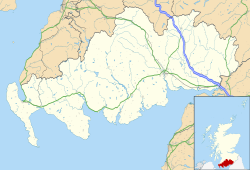| Borness | |
|---|---|
Location within Dumfries and Galloway | |
| OS grid reference | NX6145 |
| Council area | |
| Country | Scotland |
| Sovereign state | United Kingdom |
| Police | Scotland |
| Fire | Scottish |
| Ambulance | Scottish |
Borness is a farm of around 1550 acres on the coast of Borgue Parish in the Stewartry of Kirkcudbrightshire (now part of Dumfries and Galloway). It is probably more of a 'fermtoun' in that several cottages are present on the farm. In the 1881 Census for Borgue, Borness supported a farmhouse with farmer, wife, 4 children, 3 female and 3 male servants, with 3 cottages (cothouses), each with a family living there. The cottars all laboured on the farm. The farmer employed in total 14 men, 6 women and 2 boys. Borness sits above the heughs (cliffs) with an outlook across Wigtown Bay and the western portion of the Solway Firth.
